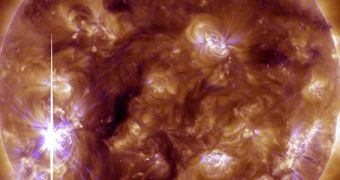The image above shows an intense, but short solar flare that was released from the surface of the Sun on Tuesday, November 5. Following on the footsteps of nearly 25 other flares that occurred over the past two weeks, the new event was so intense that is was classified as an X3.3 solar flare.
X-class solar flares are the most energetic our Sun can produce. The new emission did not occur from the same active solar region that yielded the others. The NASA Solar Dynamics Observatory (SDO) satellite was, as always, on station to capture the event at ultraviolet wavelengths.
The telescope measured the Sun at 193 and 131 angstroms, at 5:12 pm EST (22:12 UTC), when the short-lived flare achieved its peak intensity. The long vertical streak of light to the left of the image is caused by numerous protons overpowering the camera on the SDO.
Interestingly, this flare was accompanied by a magnetic crochet, which is a bump or sudden variation in Earth's magnetic field that can be recorded from the surface. Experts have warned that the flare may trigger localized and sporadic communication losses.

 14 DAY TRIAL //
14 DAY TRIAL //